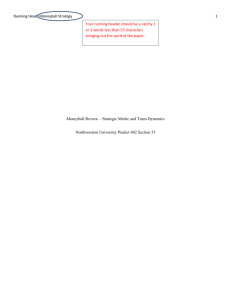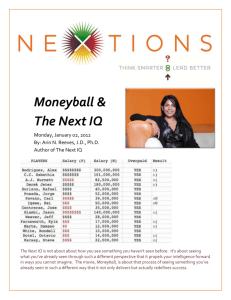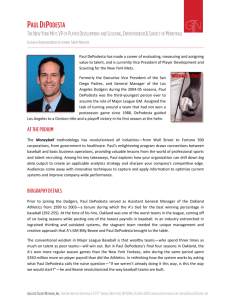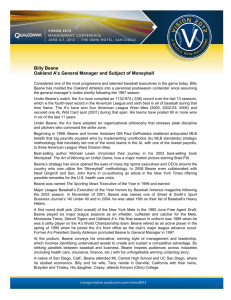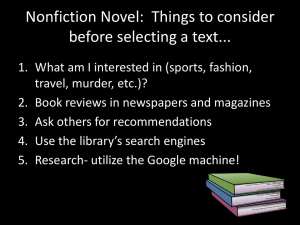Moneyball: Organizational Behavior
advertisement
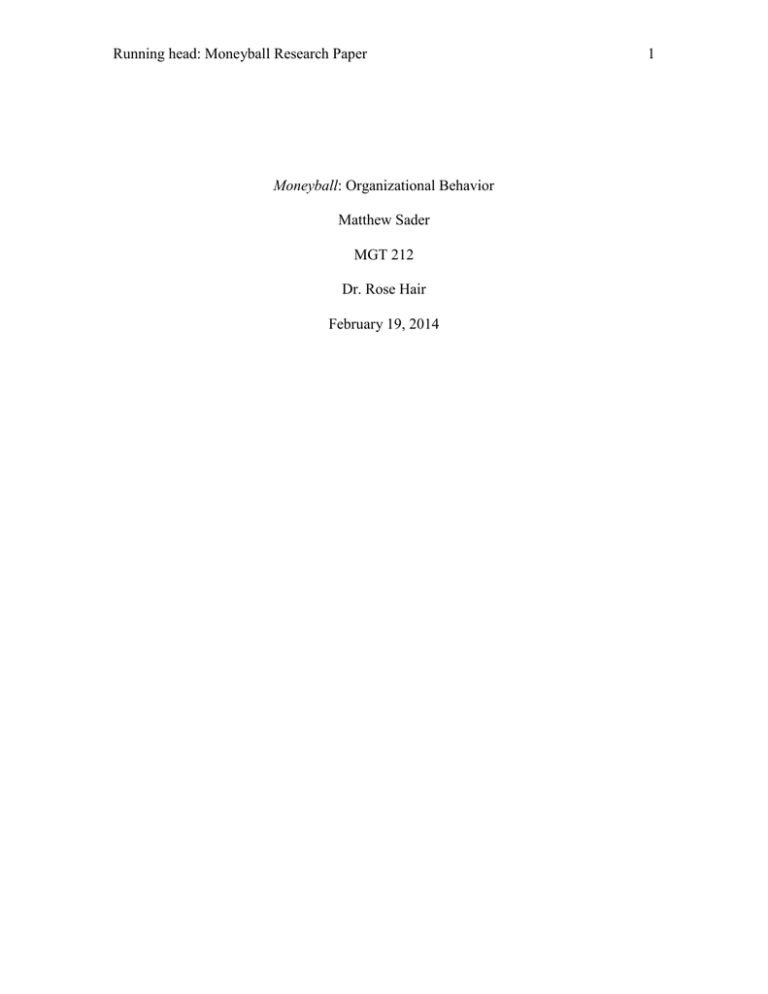
Running head: Moneyball Research Paper Moneyball: Organizational Behavior Matthew Sader MGT 212 Dr. Rose Hair February 19, 2014 1 Moneyball Research Paper 2 Moneyball: Organizational Behavior Organizational behavior is the study of what people think, feel, and do in and around organizations (McShane & Glinow, 2012). The behaviors that people exert within any establishment affects how the organization operates. Organizations are described as groups of people who work interdependently toward some purpose (McShane & Glinow, 2012). Whether it is a school, church, bank, or company, they all are groups of people working toward a common purpose while using different behaviors. In the movie, Moneyball, starring Brad Pitt and Jonah Hill, a professional baseball team called the Oakland Athletics display organizational behaviors that are evident throughout the film. These behaviors that the Oakland Athletics show are behaviors that many other organizations experience and are good examples of how these behaviors are incorporated into an organization. Moneyball is about the Oakland Athletics general manager, Billy Beane, trying to turn around the team into a winning franchise. The team recently lost three key players to other teams during the offseason and the upcoming season was looking as if it was going to be rough. While trying to negotiate a trade with another baseball team, the Cleveland Indians, Billy Beane meets an assistant who is employed with the Indians named Peter Brand. Peter Brand is a very smart man; he graduated from Yale University and had a degree in economics. Beane notices that the Indians listened to Brand while he was trying to negotiate a trade with the team. Beane questioned why a professional sports franchise would listen to an employee who is merely just an assistant. The Indians listened to Brand because he has a brilliant mind and knows how to create a winning baseball team. A few days later, Beane buys Brand from the Indians and names him as assistant general Moneyball Research Paper 3 manager. Peter Brand has an unconventional and innovative way of creating a winning baseball team. Typically a team will evaluate the current team they have, decide what the team needs, scout other players in free agency and on other teams, and from there try to obtain the new players they want and need. Brand’s philosophy is that for a baseball team to win, they must have players score runs and get on base while the other factors of baseball are less important in this philosophy. Brand accomplishes creating a team that fits this style by using computer-generated analysis that involves mathematical calculations. This allows the team to figure out what players they need, which players are “hidden gems”, and how to get the players at a cheap price. They need the players cheap because the team is struggling financially. When the season starts, the teams struggles and this new philosophy Beane and Brand are trying to implement is considered a failure by many people. As the season progresses, the team starts winning more games and eventually makes it far into the playoffs. The Oakland Athletics eventually lose and fail to reach the World Series. This was a failure in the eyes of the general manager, Billy Beane, yet him and Brand proved that this new and unconventional method not only worked, but was successful too. The new theory they used was called “Moneyball” (Zaillian & Sorkin, 2011) The “Moneyball” method used within the organization shows how many organizational behaviors are used everyday in all organizations around the world, even a baseball franchise. The general manager of the Oakland Athletics played a big role in the behavior of the organization. Besides the owner of the team, Billy Beane had total control over what Moneyball Research Paper 4 the organization decided to do. Beane, with help from Peter Brand, implemented the term “Moneyball” as their team goal. Achieving this goal would have to do with their organizational effectiveness, or how well a company can achieve their goal (McShane & Glinow, 2012). These goals being: replace three key players they lost, make money, and create a championship-winning baseball team. If the team achieves these goals then their organizational effectiveness is good; if they do not achieve these goals, the effectiveness is bad. The goals they set were good goals to set. They are, after all, what every team wants to do, which is make money and win championships. The “Moneyball” theory is at first criticized very much by the public and even within the team itself, especially since the team has a rough start. Although the theory was not working at first, Billy Beane and Peter Brand both had a perception of the theory and stood by it the whole time. Perception is defined as the process of receiving information about and making sense of the world around us (McShane & Glinow, 2012). Beane and Brand’s perception of “Moneyball” is that they knew it was a good plan and they knew it was going to work. It did not matter what the world was saying about the plan, they stood by it and knew it was going to be successful. Billy Beane’s personality and performance contributed to the “Moneyball” theory and the team’s success. Performance of a task is defined as goal-directed behaviors under the individual’s control that support organizational objectives (McShane & Glinow, 2012). A person’s performance is said to be calculated by a simple formula: performance = person x situation (McShane & Glinow, 2012). Billy’s performance is fueled by his aggressive and determined personality and the situation of the organization. Moneyball Research Paper 5 Beanes’s personality can be said to have an extraversion personality dimension. A person who has an extraversion dimension is said to be outgoing, talkative, energetic, sociable, and assertive (McShane & Glinow, 2012). These traits fit Beane very well, especially assertiveness, and are what allowed him to achieve the “Moneyball” goals he is determined to reach. He has little empathy for the people around him so he was not afraid to handle any situation, which is why he is considered an aggressive person. The situation the team was in and Beane’s past are what made him become a motivated and determined individual. Beane saw that no one was willing to give the Oakland Athletics any chance that season to be considered a good team. They lost three key players and had little money to work with. Beane was determined to prove all the doubters wrong. Motivation represents the forces within a person that affects his or her direction, intensity, and persistence of voluntary behavior (McShane & Glinow, 2012). The “Moneyball” theory was the direction of the team, the assertive personality was his intensity, and the determination to turn the Athletics around was his persistence. The past of Billy Beane also contributed to the motivation within himself. Throughout the movie, Beane looks back into his past revealing what made him become the individual he was. When Beane graduated from high school, he was considered one of the best baseball prospects and was offered to become a player in the MLB rather than enrolling in college. Beane took that option and joined the MLB. After he joined, he had not performed well and was eventually considered a failure (Zaillian & Sorkin, 2011). This angered Beane knowing he could not live up to the expectations the world expected of him. He now turns that anger from the past into his motivation to make the Oakland Athletics a championship-winning team. Moneyball Research Paper 6 The performance caused by the motivation of Beane and the situation of the Athletics affects the organization in tremendous ways. The MARS Model can help further explain this. The MARS Model shows how certain variables affect the behavior and results of an organization (McShane & Glinow, 2012). Motivation, ability, and role perceptions are what MARS stands for and all influence the organization (McShane & Glinow, 2012). The motivation Beane installed in the organization helped the team become a very successful baseball club during that season. Without the motivation, the team probably would not have went deep into the playoffs and set the longest winning streak in MLB baseball history (Zaillian & Sorkin, 2011). The ability the team had also aided in the team’s success. Everyone thought the Athletics had a bad team because they could only afford cheap players. The “Moneyball” theory helped the team afford players who were good players even though they were cheap. The team had the competencies to win. Competencies are personal characteristics that lead to superior performance (McShane & Glinow, 2012). The team had the ability to win and have a superior performance over other teams. Lastly in the MARS Model is the role perception. Role perceptions are beliefs about what behavior is required to achieve the desired result (McShane & Glinow, 2012). The team believed that the “Moneyball” theory is what was needed to achieve the desired result, which is to make the Athletics a successful, championship-winning team. Motivation plays a huge part throughout Moneyball. The other components stated so far played a big role in the film, yet motivation stood out amongst them all. To Billy Beane, motivation was what drove him to accomplish the organization’s goals. In an Moneyball Research Paper 7 article by the Human Capital Magazine regarding motivation in the workplace, it stated that motivation is personal; it is about working with and for people you trust and respect (Miller , 2014). This is exactly what Beane had in his workplace. His motivation came within himself; the motivation came from the team’s situation and from his past. He was highly motivated personally to turn the Athletics around. He also worked with people he trusted and respected. Peter Brand, who was by Beane’s side throughout the whole movie, was someone who Beane trusted and respected. With Brand’s trust and respect, this helped Beane bring in players to the team who he also trusted and respected. There were moments in the film where the players were satisfied with poor performance; they were happy, yet not motivated. When Beane saw that the players were satisfied with being a losing team, he was very angry with the team. Beane stormed into the locker room, saw the team was happy and dancing after a lose, yelled angrily at the team, and told them to never be happy with losing. In the article stated earlier, it had a comment Aristotle made about workplace motivation and it read, “the aim of the wise is not to secure pleasure, but to avoid pain” (Miller , 2014). Beane was not trying to avoid the pain of a loss. Beane took losing very seriously and was trying to give the team motivation to win and never accept losing. A large amount of the motivation that came from Beane was spread throughout the organization. Being the general manager of the team, it was somewhat part of his job to motivate the team. It is said that a manager has a direct and profound influence over workplace pleasure and workplace pain (Miller , 2014). Any environment a manager creates, he or she can either intentionally or unintentionally create motivation (Miller , Moneyball Research Paper 8 2014). Beane created workplace pleasure by intentionally motivating the team to win and never accept the pain of losing. A real life example of how motivation influences a workplace can be found in an article by Forbes Magazine. The magazine states that high-performing companies do a lot to motivate their employees (Lipman, 2014). The four main forms of motivation stated in the article were career development, empowerment, rewards and recognition, and leadership (Lipman, 2014). These companies all use these forms to create a better workplace with motivated employees. Employees who are offered with the following have a better workplace and are often much more motivated: availability of long-term career opportunities and training, open and supportive cultures that encourage new ideas and empower staff, reward benefits and non-monetary recognition, and leaders who have the ability to communicate to everyone and make decisions that are consistent with company values (Lipman, 2014). It has been stated again and again throughout this reading, the goal of the Oakland Athletics was to turn around the team and create a championship-winning franchise. What the people thought, felt, and did throughout the organization all went towards accomplishing that goal. The organizational behaviors the people exerted in the film, Moneyball, affected the organization in many ways. Their theory “Moneyball” represented the team’s goal and motivation was a major factor that helped make the team a better overall organization, which was further exemplified in the Forbes article. Terms such as the MARS Model also helped identify the behaviors showed in the film. Organizational behavior is everywhere in the workplace and the film, Moneyball, is just one example of what happens everyday in the world. Moneyball Research Paper 9 References Lipman, V. (2014, February 14). New Study Shows How High-Performing Companies Motivate Their People. Retrieved February 23, 2014, from Forbes : http://www.forbes.com/sites/victorlipman/2014/02/14/new-study-shows-howhigh-performing-companies-motivate-their-people/ McShane, S. L., & Glinow, M. V. (2012). Organizational Behavior. New York City, New York, United States of America: McGraw-Hill/Irwin. Miller , J. (2014, February 12). Opinion: Motivation in the workplace. Retrieved February 22, 2014, from Human Capital Magazine: http://www.hcamag.com/hrnews/opinion-motivation-in-the-workplace-183963.aspx Pitt, B., Horovitz, R., Luca, M. D. (Producers), Zaillian, S., Sorkin, A. (Writers), & Miller, B. (Director). (2011). Moneyball [Motion Picture]. United States of America: Columbia Pictures.
